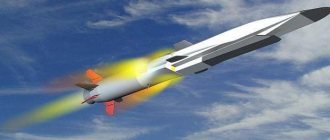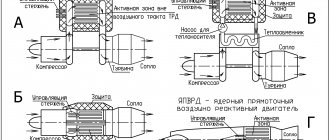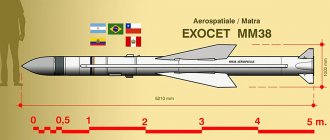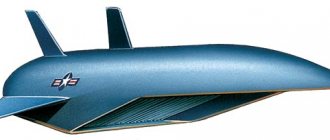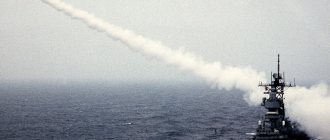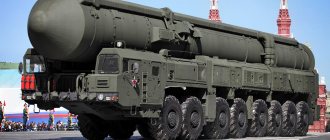Cruise missile P-35
In the mid-fifties, one of the largest and most important rocket projects of that time was launched in our country. OKB-52 under the leadership of V.N. Chelomeya was tasked with developing a cruise missile for arming submarines. At the end of the decade, this weapon, called the P-5, was put into service. Soon after the start of work on P-5, several other projects with a similar purpose were launched. One of the most noticeable results of this work was the appearance of the P-35 ship-borne cruise missile, which later became the basis for several new missile systems. After completing preliminary work on the P-5 project, it was decided to create two new cruise missiles for the navy. On August 17, 1956, the Council of Ministers of the USSR issued a decree, according to which OKB-52 was to develop the P-6 and P-35 missiles. The first was intended to arm submarines and partially replace the P-5 being developed, and the second was to arm surface ships. The P-5 project was to be used as the basis for two new missiles. It was also necessary to ensure maximum unification of the two new products.
The P-5 cruise missile, which was being developed at that time, had several important features that distinguished it from previous weapons of a similar purpose, but it was not without its shortcomings. The main one was the use of an autopilot without any homing systems. Because of this, such a missile could only be fired at area targets with a sufficiently large CEP. In the case of two new projects, the terms of reference immediately stipulated the use of control and guidance systems. This required the use of a new combined system. For most of the flight path, the missiles had to be controlled by a radio command system, and targeting the target in the final section was the task of a promising homing head.
P-35 missile on a transport trolley. Photo Warships.ru
The requirement to unify new missiles with the product being developed has simplified their design to a certain extent. For this reason, the P-35 missile turned out to be very similar in appearance to the basic P-5, as well as to the P-6, intended for submarines. However, for various reasons, several innovations of one kind or another had to be included in its design. The most noticeable differences between the P-35 and other missiles in the family were the presence of a conical central body in the air intake, as well as the launch engine fairing. P-5 and P-6, in turn, had a simple unregulated air intake, and their starting boosters had the form of two cylinders with nozzles, connected to each other and without additional aerodynamic elements.
Other exterior features of the P-35 missile were similar to other products in the family. There was a cylindrical fuselage with an ogive-shaped head fairing. Under the central part of the bottom there was an air intake for the main engine, which sharply changed the cross-section of the fuselage. Toward the tail, the fuselage shrank again and acquired a circular cross-section, ending with a sustainer engine nozzle. The total length of the rocket slightly exceeded 10 m. The diameter of the fuselage was 1 m.
The main aerodynamic surface of the P-35 rocket was a folding swept wing with a span of 2.6 m. In order to reduce the transverse dimensions of the product in the transport position, an automatic wing layout was developed within the framework of the P-5 project. A small section of the center section was rigidly attached to the fuselage, and the main part of the planes was folding consoles. In the transport position, the consoles had to be positioned vertically and secured with special locks. After the missile exited the launch container, the automation had to independently lift the consoles and secure them in this position, ensuring correct flight. With the wing folded, the transverse dimension of the rocket did not exceed 1.55 m.
Model of the P-35 rocket with holes to demonstrate internal components. In particular, the radar seeker antenna is visible. Photo Bastion-karpenko.narod.ru
For control, the rocket received a set of planes and rudders in the tail section. There were small all-moving stabilizers - elevators and a keel with a rudder. To reduce the size of the rocket, the keel was located under the fuselage, and next to it there were mounts for the jettisonable starting engine.
The power plant of the P-35 missile was similar to previous products of the family. For the launch, it was proposed to use a dual solid-fuel booster with a thrust of more than 36 tons with a fuel reserve of 2 sec. The flight was proposed to be carried out using a KRD-26 turbojet propulsion engine with a thrust of 2250 kg. The turbojet engine was supposed to provide an average flight speed of 1250 km/h. At the same time, the exact operating parameters of the power plant depended on a number of factors, both on the flight program and on the ambient temperature. According to reports, acceleration to 1,600 km/h was possible under certain circumstances.
The P-35 rocket had a launch mass of about 5300 kg. Of this, 2330 kg was the dry mass of the rocket and about 800 kg was the detachable starting engine. In the central part of the fuselage there was a compartment for mounting a warhead weighing up to 1000 kg. To hit a target, it was proposed to use a high-explosive charge or a special warhead with a power of, according to various sources, 20 kt.
The use of the P-6 missile for third-party target designation and signal relay. The general principles of such operation are similar to the “M” mode of the P-35 missile. Drawing by Shirokorad A.B. Weapons of the domestic fleet. 1945-2000.
The control systems for the new cruise missile were developed simultaneously with the equipment for the P-6. At the same time, it was decided to add some new devices to it. It was proposed to use already existing guidance systems with some new units in the “M” (“sea”) mode to attack surface targets. The new mode “B” (“coastal”) was intended for attacking stationary objects on the shore. The full range of control equipment was designated APLI-1.
When using mode “B”, the automation, having received the coordinates of the target, had to rise to a high altitude and automatically follow to the target area. At some distance from the target, the missile was supposed to go into a dive with a large angle and hit a given object.
Mode "M" was more complex and involved more equipment. Immediately after launch, the rocket had to rise to a height of 7-7.5 km and maintain a given course using the autopilot. In this case, the operator of the missile system had to monitor the missile and adjust the direction of its movement. Having noticed the deviation of the rocket from the given course, the operator had to control its rudder. At a distance of about 40 km from the target, an active radar homing head was activated. At first, it was supposed to work as a remote radar: monitor the area, and also transmit the received data about the objects found to the operator’s console. Having identified the target, the operator had to give the command to capture. After this, the seeker began to independently track a given target and point the missile at it. The last leg of the flight was supposed to take place at altitudes of about 100 m. A similar algorithm for the operation of guidance systems made it possible to fire in one salvo with the distribution of targets among several missiles.
Missile launch from the cruiser "Grozny" pr. 58. Photo: Militaryrussia.ru
To detect targets, the carrier ship had to use standard radar stations provided for by its design. It was proposed to control the rocket using the Binom system. Over time, a version of the control complex appeared, designed to significantly increase the range of missiles. In this case, an airplane or helicopter with radio signal relay equipment appeared between the carrier ship and the target. Depending on various factors, including the use of repeaters, the flight range of the P-35 missile could reach 300 km. Tu-16RTs and Tu-95RTs aircraft, as well as Ka-25RTs helicopters, could be used as carriers of auxiliary equipment.
It was proposed to launch new missiles using special launchers with separate containers. By the end of the fifties, TsKB-34 specialists, together with TsKB-34, developed launchers of several types. The SME-142 product allowed one missile to be transported and launched, while the SM-70 and SM-82 installations could accommodate four missiles each. These systems were intended to solve different problems, but had a partially similar design. The basis of all installations was a cylindrical container about 12 m long with an internal diameter of 1.65 m. It had rails for moving the rocket, as well as connectors for connecting to ship systems and other equipment. Both end caps of the container could be opened. The front one, when opened, provided the exit of the rocket, and the opening of the rear one removed the gases from the starting engines.
Of the three launchers, SM-82 was the first to go into operation. This product with four containers was intended for ground testing of missiles. The first launch of an incomplete P-35 rocket took place on October 21, 1959 - several months before the start of similar checks of the P-6 product. Until March of the following year, testers carried out five test launches, in which missiles without electronic equipment were used.
In 1959, a test vessel was prepared to continue testing ship-borne cruise missiles. The available bulk carrier Ilet received a single-container launcher SME-142 and a set of control equipment. After this alteration, the cargo ship was renamed OS-15. The experimental vessel was supposed to operate at testing sites in the Caspian Sea.
Launcher SM-70, used on Project 58 cruisers. Photo Warships.ru
On July 27, 1960, the former cargo ship launched the P-35 rocket with a full set of equipment for the first time. At this stage of testing, seven missiles were expended. The test results were considered unsatisfactory. The APLI-1 control equipment was still “crude” and did not show the required characteristics, which is why it required improvement. Further tests could begin only after the completion of work to improve the rocket’s equipment.
All necessary work was completed only by the end of 1962. At the same time, the OS-15 again went to the training ground to perform test firing. The new stage of trial runs turned out to be more successful. In addition, during these tests, the P-35 missile showed its full potential in hitting targets. Several shootings were carried out using targets in the form of decommissioned ships. The results of these launches were of great interest.
In one of the test launches of the P-35 missile with OS-15, a target was used - the unfinished leader of the Project 48 Kyiv destroyers. This ship was laid down in 1939 and was supposed to join the fleet in 1942, but the outbreak of war stopped construction at less than 50% readiness. In the early fifties, the unfinished Kiev became a vehicle for various tests, and testing the capabilities of the P-35 missile became its last task.
Missile cruiser "Admiral Golovko" of project 58. The SM-70 launcher is located in front of the setup. 1990. Photo: Wikimedia Commons
In experimental launches against target ships, P-35 missiles with inert equipment (with a weight simulator of the warhead) were used. The missile fired at Kiev successfully aimed at the target from its front hemisphere and hit it exactly. The rocket hit the left cheekbone of the hull. After this, the supersonic missile, due to its energy and mass, pierced the target deck at a distance of about 50 m. Due to such interaction with the target, the missile airframe was destroyed, but the main engine retained relative integrity. The engine broke through all the internal structures of the target body that were in its path, and then pierced its bottom. Water began to flow through the resulting hole, and after about three minutes the target ship sank.
According to the results of all tests, the P-35 missile and a set of corresponding equipment for ships were pleasant for service. The carriers of such weapons were to be ships of several new types. By the time the missiles were put into service, some ships had already been built, others appeared a little later.
The first carriers of the P-35 missiles were to be the new Project 58 destroyers. At the end of 1956, the shipbuilding industry received technical specifications for the development of a similar ship, which took into account the use of new cruise missiles. The technical design of the new ships was prepared at the beginning of 1958, after which preparations began for the construction of future missile carriers. Interestingly, during the first few years, Project 58 managed to change its classification several times. Initially, these ships were considered destroyers, but the proposed weapons did not meet the requirements for such ships. As a result, the designation “ship with jet weapons” appeared. Only in 1962, after a demonstration of P-35 ships and missiles to the country's leadership, Project 58 was designated as a cruiser.
Missile cruiser "Vice Admiral Drozd" of Project 1134. KT-35 launchers are located on the sides of the superstructure behind the tank. 1985 Photo: Wikimedia Commons
The P-35 missile was to become the main strike weapon of ships of the new project, designed to attack surface and ground targets. Each Project 58 cruiser received two SM-70 launchers located in front of and behind the superstructure. The design of the installations made it possible to direct missiles horizontally within a sector 120° wide and raise them to an elevation angle of up to +25°. In order to avoid damage to the superstructure during an attack, the ship had to go at a certain angle to the missile’s flight path and rotate the launcher to the desired angle, venting the gases of the starting engines overboard. The Project 58 cruisers' ammunition consisted of 16 P-35 missiles. Eight products were stored directly in launch containers, the rest were located in two cellars near the installations. According to some reports, the standard ammunition of the ships was 12 missiles with a high-explosive warhead and 4 with a special one - one for a full salvo of the launcher.
Initially, it was planned to build 16 Project 58 ships, but later the series was reduced by four times. From 1962 to 1965, the cruisers Grozny, Admiral Fokin, Admiral Golovko and Varyag were included in the navy. New ships were distributed among all major fleets. At the same time, in the future, some ships of the project were transferred several times to other fleets. Most of the Project 58 cruisers continued to serve until the early nineties, after which they were decommissioned. The most “survivable” was the ship “Admiral Golovko” from the Black Sea Fleet, which completed its service only in 2002.
During the testing and service of Project 58 cruisers, it was found that existing launchers with their own guidance systems do not have high performance and in fact do not make sense. For this reason, in the mid-sixties, a new system, KT-35 or KT-35-1134, was developed. It included two stationary inclined containers. Guidance systems were not provided; it was possible to shoot only forward along the course of the carrier ship.
In the second half of the sixties, four Project 1134 missile cruisers were built: Admiral Zozulya, Vladivostok, Vice Admiral Drozd and Sevastopol. Project 1134 was to a certain extent a development of Project 58, but had a lot of differences. In particular, instead of the SM-70 rotary launchers, they received two KT-35 products located on the sides of the front part of the superstructure. There was no provision for reloading the launchers, which is why the ammunition load consisted of only four P-35 missiles.
Launcher of the Redut coastal missile system. Inside the container is a P-35 missile. Photo Rbase.new-factoria.ru
Project 1134 cruisers served in the Northern (three ships) and Pacific (one) fleets. In the late eighties and early nineties, these ships were decommissioned and scrapped due to moral and physical obsolescence, as well as financial problems of the navy.
The advent of the P-35 cruise missile made it possible to significantly increase the strike potential of naval ships and increase the range of destruction of surface targets. With the correct organization of target search, target designation and missile strike, the attack range of enemy ships reached 300 km. In addition, it was possible to destroy ground targets with previously known coordinates at similar distances.
However, the P-35 complex had some disadvantages, the main of which, however, were related not to the design of the missiles, but to the number of their carriers. During the sixties, only eight missile cruisers with launchers for the P-35 were built. Project 58 cruisers could carry eight ready-to-use missiles and the same spare ammunition, while Project 1134 cruisers carried no more than four missiles. Naturally, the full implementation of plans for the construction of 16 Project 58 cruisers could further increase the strike potential of the fleet, but only four such ships were built. The situation was similar with the Project 1134 cruisers.
The P-35 cruise missile became another variant of the development of the ideas contained in the original P-5 project. However, it did not become the last development of its family. Already in the mid-sixties, several new projects began, the purpose of which was to develop the existing design and improve its characteristics. Thus, a new Progress missile was proposed for use on ships, and coastal troops were to receive the Utes and Redut missile systems. Thus, the original project was developed again and led to another increase in the potential of the USSR Navy.
Based on materials: https://rbase.new-factoria.ru/ https://warships.ru/ https://bratishka.ru/ https://flot.sevastopol.info/ https://militaryrussia.ru/blog /topic-392.html Shirokorad A.B. Weapons of the domestic fleet. 1945-2000. – Mn.: “Harvest”, 2001
Can Granit destroy a modern AUG?
Disputes regarding the P-700's ability to hit an aircraft carrier have been going on for quite some time. Theoretically, Granit anti-ship missiles pose a great danger to any warship, including an aircraft carrier. But there is one problem that reduces all the advantages of this missile to almost zero. This is targeting.
When firing at long distances, the P-700 homing head cannot independently lock onto a target; it needs target designation, which theoretically can be carried out from airborne vehicles or from space.
To destroy an enemy AUG using Granit, a Russian submarine or surface ship must detect and classify the target, approach it within salvo range, and fire missiles that can hit enemy ships. It should not be forgotten that carrier strike groups are very difficult targets. They are extremely protected by a wide variety of air defense, missile defense and electronic warfare systems, constantly maneuver, have a powerful aviation group, and are covered by submarines. Hitting this target (and even getting close to it within the range of a missile salvo) is very difficult.
The current Russian fleet is extremely limited in terms of target detection. Their detection radius is usually limited by the radio horizon. The helicopters that some Russian warships have are of little use for solving this problem, primarily due to their short range. It is ineffective to carry it out using the Tu-95RTs aircraft, since a reconnaissance aircraft sometimes needs a large number of hours to arrive in a certain area of the World Ocean.
During Soviet times, the use of nuclear submarine cruisers equipped with Granit anti-ship missiles was based on a powerful naval reconnaissance system, which had information about a potential enemy in all zones of the ocean theater of operations.
Its basis was ground-based radio intelligence centers located both on the territory of the USSR and beyond its borders. You can recall similar centers located in Cuba, Vietnam (Cam Ranh), and South Yemen. Today there is none of this.
In addition to ground bases, the Soviet Union had an effective space reconnaissance and target designation system that could detect an enemy ship almost anywhere in the World Ocean. And not only to detect: this system constantly monitored the AUG of a potential enemy and, in the event of war, could provide target designations for missile weapons.
The Granit anti-ship missile system can be called only one of the components of the Soviet aircraft carrier destruction system; its second element was the Legend space target designation system. It began to be developed in the mid-70s under the leadership of Academician Keldysh.
The Legend project consisted of creating a satellite constellation in low-Earth orbit capable of transmitting information about the movement of surface targets and producing target designations for missile weapons. This group included both active (radar) and passive (bearing of objects) reconnaissance devices. The Legend system was capable of targeting Soviet missiles at any point on the earth's surface.
However, at the moment, “Legend” has long been history. In 1998, the last satellite constellation completed its work. Currently, a similar system “Liana” is in the formation stage.
Therefore, any Russian ship equipped with Granit anti-ship missiles will be detected much earlier than it can approach the launch distance of these missiles. If we talk about launching missiles from a submarine, then this has its own difficulties.
To fire a successful salvo of P-700 missiles, the submarine must enter the near zone of the anti-submarine defense order, where the probability of detecting a submarine will be very high. Even with a successful missile launch, not all of them will be able to achieve their goals, since the AUG has very strong air defense and missile defense.
Today, the likelihood of the destruction of an American aircraft carrier by any means of attack at the disposal of the Russian Navy seems very unlikely. Without resuscitating the global intelligence system, this will be very problematic. Unless nuclear warheads will be installed on the missiles.
Author of the article:
Nikiforov Vladislav
Comparison with other anti-ship missiles
If we compare the Granit missile system with its foreign analogues, we must admit that this missile is the best today.
The launch weight of the 3M45 missile is ten times (!!!) greater than the similar parameters of the American Harpoon anti-ship missile. Also, “Granit” is more than twice as large as the American in terms of warhead mass, and twice as fast. The P-700 has a five times greater range.
There is an even greater difference in characteristics with the French Exocet anti-ship missile, the Chinese S-802 and the Israeli Gabriel.
The destructive power of the 3M45 missile allows one hit to destroy a modern destroyer or cruiser. To guarantee the destruction of an aircraft carrier, 8-10 such missiles are needed.
These Soviet missiles are really good and have no analogues in the world, but there is one problem associated with detecting a target and aiming the P-700 anti-ship missiles at it. It is she who is the “Achilles heel” of this complex. This makes us doubt that Granit missiles can sink a modern aircraft carrier.


